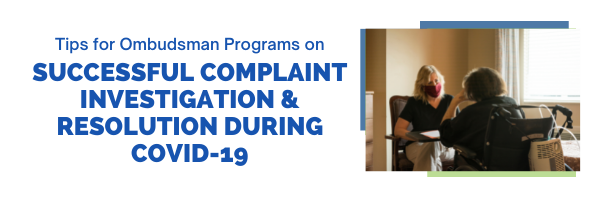
Ombudsman programs are to investigate and resolve complaints, with maximum resident participation in the process, and with a goal to resolve the complaint to the satisfaction of the resident or complainant. Below are tips to provide advocacy strategies in response to common complaints during the COVID-19 pandemic. These tips are from the resource, Complaint Investigation and Resolution During COVID-19: Complaint Scenarios and Documentation, which was updated in May 2021.
Scenarios
Below is an abbreviated list of common scenarios and advocacy strategies. To read the full scenario and NORS coding examples, review the resource linked above.
A facility denies in-person visitation by the Ombudsman program.
- Review state guidance regarding reopening facilities and visitation and relevant CMS guidance to confirm whether in-person visits are allowed before contacting the administrator.
- CMS revised (4/27/2021) guidance letter to state survey agency directors advises:
- Core Infection Prevention Practices remain the same – screening for symptoms of infection, hand washing, wearing of masks, physical distancing, and cleaning and disinfecting high-frequency touched areas.
- Outdoor visitation is preferred.
- Facilities should allow indoor visitation at all times and for all residents (regardless of vaccination status), except for a few circumstances when visitation should be limited due to a high risk of COVID-19 transmission (note: compassionate care visits should be permitted at all times).
- If the administrator denies access, explore the reasons why (e.g., a current or recent outbreak of COVID-19, a mandate from corporate). If the Administrator continues to deny access to visit with residents inside the facility due to current infectious disease protocols in place for COVID-19, contact the local public health authority and/or state survey agency to confirm whether restricting in-person access was appropriate.
- Ask how to set up visits with residents outside the building if visits inside the building are currently restricted.
- Inquire about resident access to electronic devices (e.g., iPads, tablets, smart phones, computers) and staff assistance to facilitate virtual contact.
- Ask about their visitation process (e.g., can family members, friends, religious leaders, and others visit in-person; face coverings and/or personal protective equipment (PPE); scheduling visits; how they inform residents, families, and others of the process).
A resident would like to transfer to their original facility after they were making her nursing home a COVID-19 unit for those residents presumed or testing positive for COVID-19.
- There are two CMS guidance letters that focus on transfers and discharge notices to residents. The first guidance was in reference to temporary waivers provided during the national pandemic. The second guidance rescinds the waiver of transfers and discharges without proper notice to residents.
- Investigate the circumstances of the move and what notification and assurances, if any, the facility made to residents and families about returning to the original facility. Determine whether the original facility can safely receive the resident back at this time or sometime in the future (e.g., will facility allow them to return to their room, will they have the same roommate). Ensure that the facility staff shares their plans regarding the temporary transfer and return to the original facility with family members.
- Provide information on resident and family councils as another way to stay informed on issues related to the transfer.
Find more resources and suggestions on our COVID-19 Recovery and Reentry Resources for Ombudsman Programs webpage.
Webinar Materials Available
Webinar on Successful Complaint Investigation and Resolution During COVID-19
This webinar was the third in the three-part COVID-19 Recovery and Reentry: TA Open Dialogue Webinar Series that provided a brief overview of the COVID-19 Recovery and Reentry Resources, shared successful program practices, and provided time for questions.
This webinar explored how Ombudsman programs have successfully advocated with and for residents, despite in-person visitation restrictions and other barriers. View the recording and webinar materials included:
Read archived issues of NORC Notes here. If you have a question, are not able to find a resource, or want to share training materials or program practices, please email ombudcenter@theconsumervoice.org.

